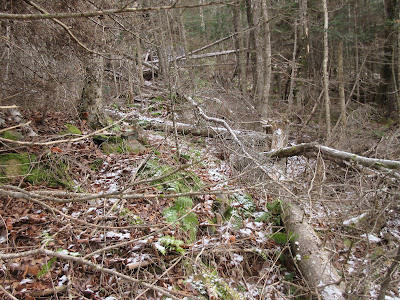Chose a comfortable late November day for a return visit to an old, mostly overgrown slide on the steep east face of Mount Braley, a southeastern spur of Mount Moosilauke, located along the Blue Ridge just south of Mount Waternomee. This 3770-ft. peak is informally named for Warren Braley, a prominent member of the Dartmouth Outing Club in the early 1930s. Braley was instrumental in building the DOC's Jobildunc Cabin in Jobildunc Ravine, after obtaining permission from Sherman Adams, head of the Parker Young Co., which owned the land at the time. The cabin was abandoned after the 1938 hurricane wreaked havoc in the ravine.
The best spot from which to view this slide is from the frozen surface of Elbow Pond in midwinter. The age of this slide is unknown, though it certainly fell before 1960. It is almost completely revegetated with red spruce, but, as I discovered on my previous visit in 2014, there are still two open patches that reveal unique views.
The approach route for this bushwhack was the Walker Brook logging road off Rt. 118 at the Woodstock end of that highway. This also serves as the approach for the unofficial path to the 1942 B-18 bomber crash site, which is on the slope to the north of the old slide at about the same elevation.
At an open logging yard at the end of the gravel road, a cairn and small American flag mark the start of the bomber crash path.
I continued ahead across the north branch of Walker Brook and began bushwhacking up the ridge between the north and south branches of Walker Brook.
The slopes drop off steeply to the ravine of the south branch.
The middle part of the whack ascended through a huge 1980s clearcut, now grown to saplings with lots of down junk wood.
In the woods there was crunchy, punchy snow perhaps two to three inches deep, making for somewhat tedious travel.
One of the feeder streams of the south branch, high up on the slope.
I remembered this fine open hardwood glade on a shelf at 2600 ft., just below the slide.
Nearby is one of the runout tracks of the old slide.
I followed this track upward.
One of the few ledges on the slide track.
At the lower of the two remaining open patches, the southeastward view was still good.
Unique to this vantage point is the bird's-eye view of Elbow Pond, with Sandwich Dome beyond.
The upper end of this open patch.
The spruces close in above.
Grouse tracks.
The upper open patch, at 3050 ft.
Looking out.
An even better view over the pond up here. Nice spot for a long lunch break.
Zoom on Elbow Pond.
Descending steeply through the woods alongside the slide.
Hardwood dreams.
During this bushwhack I crossed tracks several times with what I assume was a wandering bear. No sightings, though.
Homeward bound, following more critter tracks down the long slope.






































































